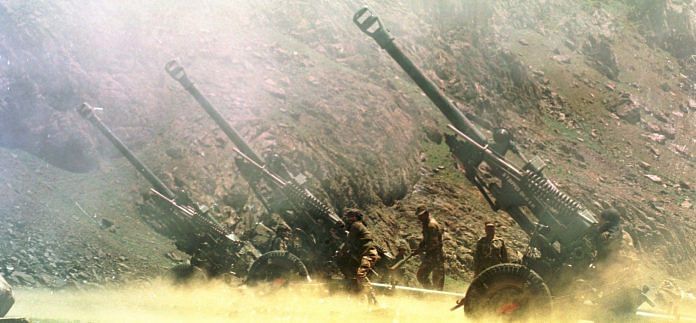Kargil demonstrated the growing resilience of the Indian nation-state to concurrently cope with various genres of modern conflict.
General Pervez Musharraf was an artillery officer who had built an excellent reputation over the years as a founding member of the Special Service Group, the Pakistan Army’s elite commando unit. By the time he became chief of army staff, he had a band of loyal generals who cut across sectarian divides and ensured that the Kargil operation was planned in complete secrecy.
In Rawalpindi, the plan was orchestrated by Musharraf’s chief of general staff Lt. Gen. Muhammad Aziz Khan and the corps commander of 10 Corps Lt. Gen. Mahmud Ahmed. The plan was put into practice by Major General Javed Hassan, the force commander northern area (FCNA). Brigadier Nusrat Sial, who was the senior-most Pakistan Army officer to be killed in the conflict, was in tactical command of 62 Brigade, the main brigade in operations.
An infantry officer, Aziz Khan’s strident anti-India posture and Islamic leanings blended well with his experience as a brigade commander in Siachen and subsequently as FCNA during the years of tough fighting on the Saltoro Ridge. Between him and Musharraf, there could not have been two more knowledgeable generals of the terrain and operational requirements for mounting the operation.
Mahmud Ahmed, also an artillery officer, was a regimental colleague of Musharraf’s and an Islamic hardliner who was specifically brought in by Musharraf as the corps commander of 10 Corps at Rawalpindi, and later operationally executed the coup that overthrew Nawaz Sharif in October 1999.
Ikram Sehgal, a distinguished and balanced Pakistani commentator on strategic affairs and himself an army aviator, describes Mahmud Ahmed as ‘a professional soldier with a good reputation’. Shaukat Qadir, another perceptive Pakistan analyst, has described him as ‘sharp, intelligent and arrogant – secular until he discovered the force of Islam late in his life. Consequently, perhaps, he became dangerous in the way that anyone can become if they believe they are incapable of doing wrong’.
Ahmed was, without doubt, the principal orchestrator of the Kargil operations, while Javed Hassan provided the last-mile connectivity to the whole operation as FCNA. He was, according to Shaukat Qadir, ‘a highly intelligent and well-read officer, more of an academic than a commander, and bears that reputation. He, therefore, was the only one with a point to prove’.
Praveen Swami, one of India’s most persistent and perceptive analysts of the Pakistan Army, describes Javed Hassan a few years after the Kargil War: ‘Lieutenant-General Javed Hassan – who played a key role commanding Pakistan forces during the Kargil war – was commissioned by the army’s Faculty of Research and Doctrinal Studies to produce a guide to India for serving officers. In India: A Study in Profile, published by the military owned Services Book Club in 1990, Hassan argues that India is driven by “the incorrigible militarism of the Hindus.” “For those that are weak,” he goes on, “the Hindu is exploitative and domineering”’.
By any standards, Musharraf had chosen his team well! The identity of the infiltrating force was a matter of much debate for long, which was another indication of the initial success of the operation in terms of secrecy, ambiguity and creating narratives. Till mid-June, many western commentators continued to call the infiltrators ‘Islamic guerrillas’ and ‘Taliban fighters’, misled in hindsight by effective Pakistani narratives.
It was only when the Indian Army displayed IDs of Northern Light Infantry soldiers, who were captured in the Batalik Sector and killed in action in other sectors, that the world gradually uncovered the identity of the infiltrators as regular Pakistani soldiers. Towards the later stages of the conflict, these troops were reinforced by troops belonging to the Bajaur and Chitral Scouts from the Frontier Corps.
Whatever the final motivation was, the Kargil infiltration plan was a bold and audacious one that banked on speed, surprise and psychological domination. Musharraf had also read the West well and felt encouraged by a widespread feeling within the Clinton administration that any limited conflict in the sub-continent was a sure-shot recipe for a nuclear face-off and hence the need to quickly intervene, leaving Pakistan with significant gains and a giant step towards the corollary objective of bringing Kashmir back into international focus.
Its major flaw, however, was a conviction that India would offer a tepid response in a time-frame that would be elastic enough to allow international opinion to drive a negotiated settlement in a nuclear-charged environment. Though the Indian political and military leadership were strategically and operationally surprised, the ferocity of the Indian Army’s officer-led infantry assaults, its outstanding junior leadership and force-multiplier effect provided by concentrated ‘big gun’ artillery fire, and psychological degradation of the combat potential of the Northern Light Infantry by repeated IAF strikes proved to be decisive war-winning factors.
In the final analysis, Kargil was a bridge too far for Pakistan and demonstrated the growing resilience of the Indian nation-state to concurrently cope with various genres of modern conflict, albeit at heavy human cost.

Arjun Subramaniam is a retired Air Vice Marshal of the IAF, and currently, a visiting fellow at Oxford University.
ALSO READ: Kargil shows Pakistan’s magnificent obsession of getting even with India







It was widely reported back then that snow gear and other battle gear was in short supply….it.was also speculated that PAK was buying this stuff in the international mkt…..the indian intel should have understood that siachin would be a good strike option for Pakistan